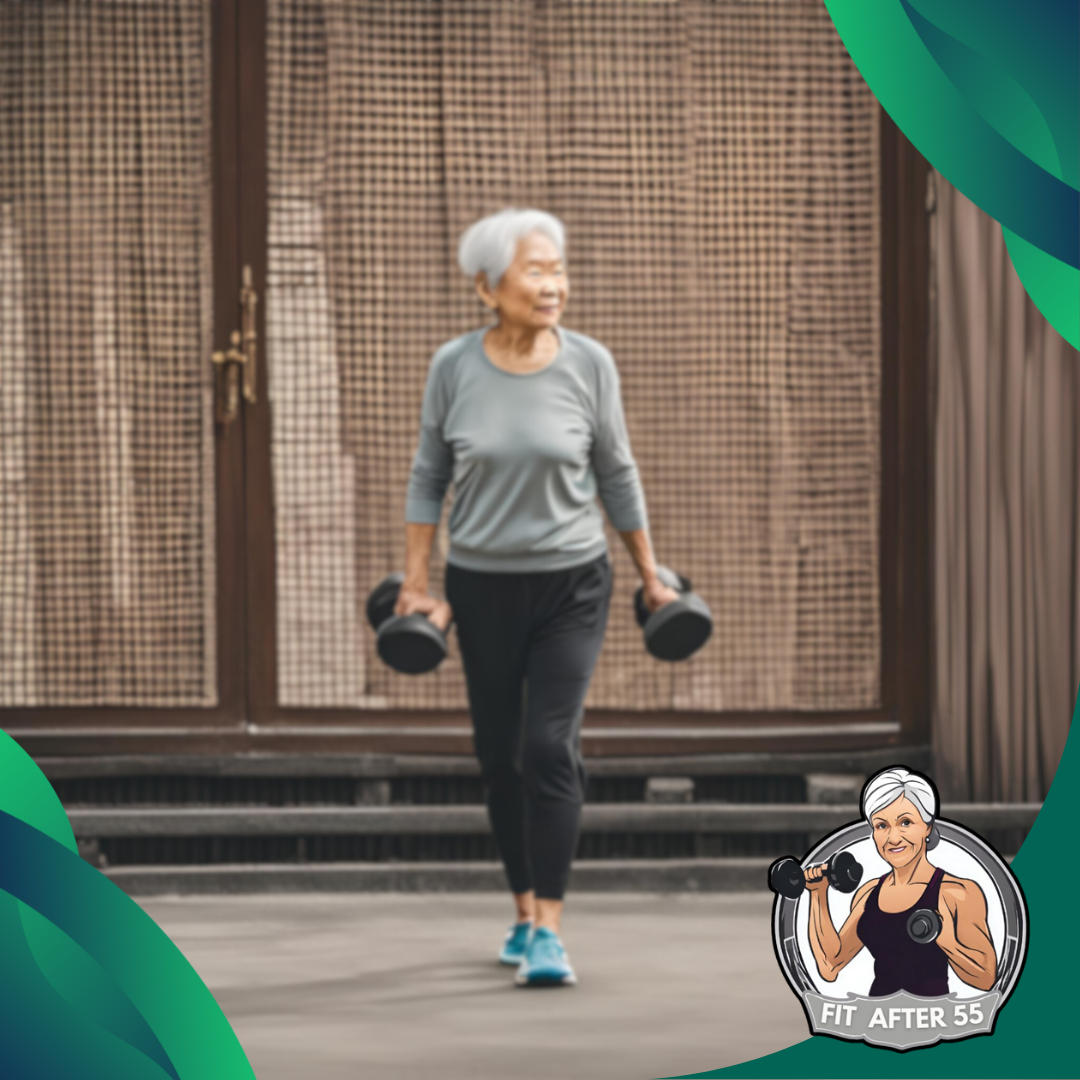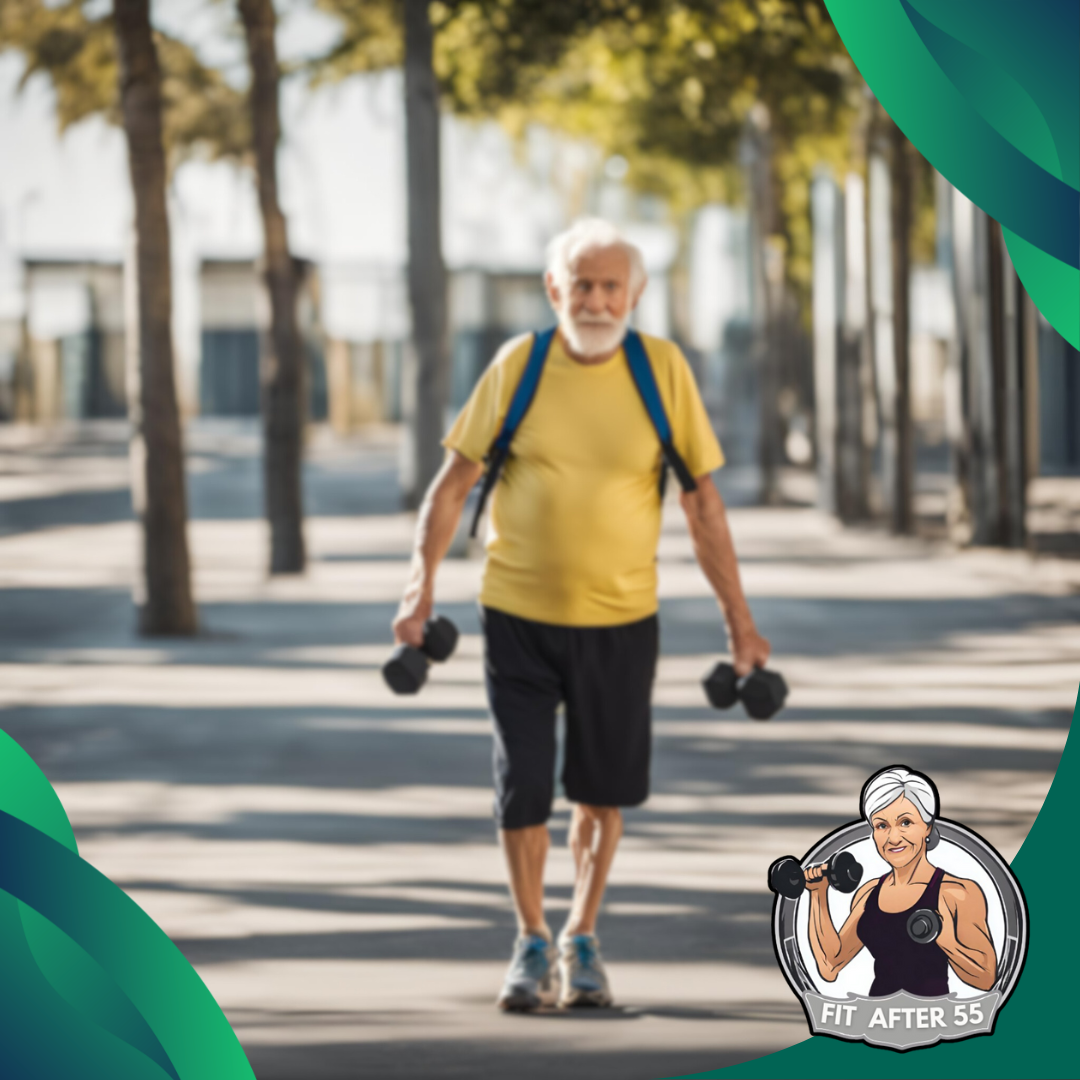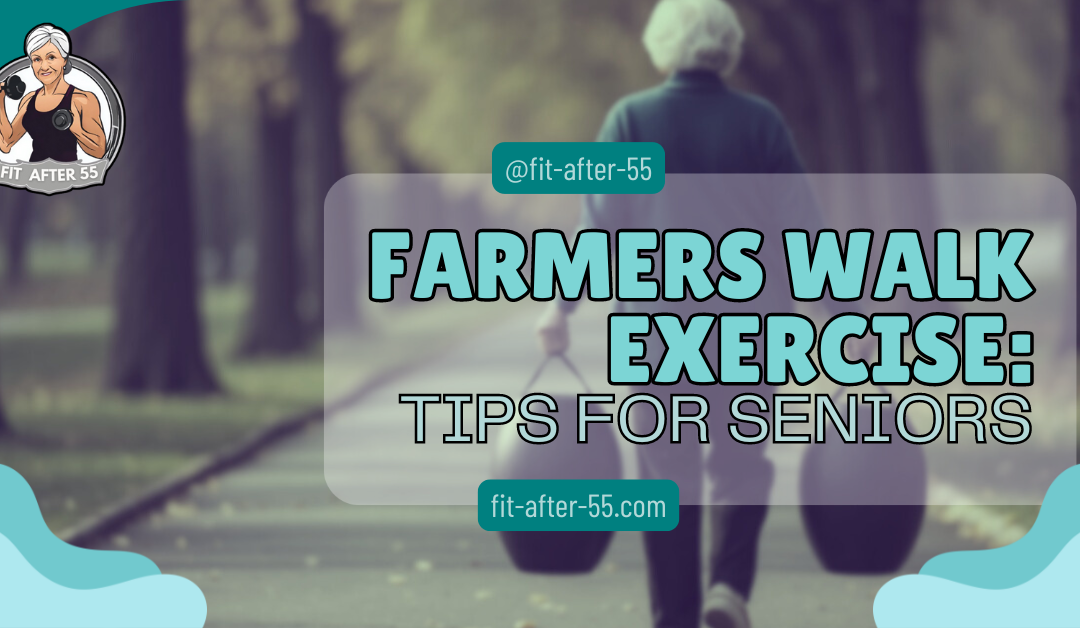Farmers walk exercise has been a staple in my workout routine for years. It’s a simple yet incredibly effective way to build strength, improve balance, and enhance overall fitness. While I grew up on a farm and was naturally drawn to this exercise, it’s amazing to see how many others have fully embraced the farmers walk as a way to improve their overall health and well-being.
Farmers Walk Exercise: Tips for Seniors – Boost Your Strength and Balance
I grew up doing the farmers walk naturally, carrying buckets of feed and water to our animals on the farm. Later, I discovered it had been worked into an actual exercise. The farmers walk exercise provides seniors great help as they work to stay strong and mobile. I’ve seen many older adults benefit from this simple yet effective workout. It’s easy to learn and can be done almost anywhere.

The farmer’s walk exercise helps seniors improve grip strength, posture, and overall stability. I love how it works multiple muscle groups at once. You just pick up weights and walk – it’s that straightforward! But don’t let its simplicity fool you. This exercise packs a punch when it comes to building functional strength.
I encourage seniors to start with light weights and short distances. As you get stronger, you can slowly increase the weight and distance. Remember to keep your shoulders back and spine straight while walking. Good form is key to getting the most out of this exercise and staying safe.
Key Takeaways
- Farmers walk exercise build strength and stability for everyday activities
- Start with light weights and progress slowly for safety
- Good form and proper technique are crucial for maximum benefits

Understanding the Farmers Walk Exercise
The farmer’s walk is a simple yet powerful exercise. I love it because it’s easy to learn and great for building strength. To do it, you just pick up heavy weights and walk.
This move works many muscles at once. It targets your grip, core, shoulders, and legs. It’s like carrying heavy grocery bags, but as a workout.
For seniors, the farmers walk exercise has special benefits:
- It improves balance
- It builds functional strength
- It’s low-impact on joints
I find it’s a good idea to start light. You can use dumbbells, kettlebells, or even water jugs. The key is to choose a weight you can carry safely.
When doing the farmer’s walk, I keep my back straight and shoulders down. I take short, steady steps. It’s important to breathe normally as you walk.
The distance you walk matters less than the time under tension. I usually aim for 30-60 seconds per set. As you get stronger, you can increase the weight or distance.
Remember, form is crucial. If you feel pain or can’t maintain good posture, it’s time to stop or lower the weight.
Benefits of Farmers Walk for Seniors

The farmers walk exercise offers many great benefits for older adults. I’ve found it can really help improve strength, balance, and fitness in several important ways.

Improved Balance and Stability With the Farmers Walk Exercise
Doing farmers walks has improved my balance and stability a lot. As I carry weights and walk, my body has to work hard to stay upright and move smoothly. This challenges my balance in a safe way.
Over time, I’ve noticed I can walk more steadily, even on uneven surfaces. My risk of falling has gone down too. The exercise strengthens my legs, ankles, and feet – all key for good balance.
I like that I can adjust the difficulty by changing the weight or distance. This lets me progress gradually as I get stronger and more stable.
Enhanced Grip Strength
My grip strength has gotten so much better from farmers walks! Holding and carrying heavy weights really works the muscles in my hands, wrists, and forearms.
Grip strength is linked to living longer according to some research. It helps with daily tasks like opening jars or carrying groceries.
I’ve found it easier to do things around the house that need a strong grip. Using tools, gardening, and even turning doorknobs have all gotten easier.
The constant tension on the weights as I walk really challenges my grip in a unique way. It’s different from just squeezing something.
Increased Cardiovascular Endurance
Farmers walks have been great for my heart health and endurance. Walking while carrying weights gets my heart rate up and makes me breathe harder.
I can feel my stamina improving over time. Tasks that used to leave me winded now feel easier. Even climbing stairs isn’t as tiring as before.
The nice thing is I can adjust the intensity. Walking faster or using heavier weights makes it more of a cardio workout. Going slower with lighter weights is still beneficial but less intense.
I try to do farmers walks a few times a week. It’s a simple way to boost my cardiovascular fitness without high-impact exercises.
Strengthened Core Muscles
My core muscles have gotten much stronger from farmers walks. Carrying weights while walking really engages my abs, obliques, and lower back.
I have to keep my core tight to maintain good posture and balance as I walk. This constant tension builds strength over time.
My back feels more supported during daily activities now. Things like bending over or lifting objects are easier and less likely to cause strain.
I’ve noticed better posture too. The exercise teaches me to keep my spine neutral and engage my core muscles. This carries over to how I stand and sit throughout the day.
Safety Guidelines

Safety is key when doing the farmer’s walk exercise. I’ll share some important tips to help seniors stay safe and get the most out of this workout.
Proper Form and Posture, Essential With the Farmers Walk Exercise
I always tell seniors to focus on their form first. Stand tall with your chest up and shoulders back. Keep your core tight as you walk. Look straight ahead, not down at your feet. This helps prevent neck strain.
Take short, controlled steps. Don’t rush or take big strides. I find it helps to imagine balancing a book on your head as you walk. This keeps your posture in check.
If you feel any pain, especially in your back, stop right away. It’s better to be safe than sorry.
Choosing the Right Weight
I can’t stress this enough – start light! For seniors new to the farmer’s walk, even carrying a 1-pound weight in each hand is okay. You can always work up from there.
Test the weight before you start walking. Can you hold it comfortably by your sides? If not, it’s too heavy.
I suggest using dumbbells or kettlebells for this exercise. They’re easier to grip than other weights.
Increase weight slowly over time. I usually recommend going up by 1-2 pounds every few weeks, as long as you feel comfortable.
Warm-Up and Cool-Down
I always start with a 5-10 minute warm-up before doing the farmers walk exercise. This gets my blood flowing and loosens up my muscles. Here’s what I do:
- Arm circles
- Shoulder rolls
- Gentle twists
- Marching in place
After the farmers walk exercise, I cool down for 5 minutes. I do some light stretches, focusing on my arms, shoulders, and back. This helps prevent stiffness later.
Don’t skip these steps! They’re crucial for preventing injuries and making the most of your workout.
Adapting the Exercise for Different Fitness Levels
The farmer’s walk is a versatile exercise that I can adjust for seniors of varying fitness levels. For beginners, I recommend starting with lighter weights, like water bottles or small dumbbells.
As strength improves, I suggest gradually increasing the weight. The key is to find a challenging but manageable load.
For those with balance issues, I advise using a walker or shopping cart for support. This allows them to still get the benefits of the farmer’s walk exercise while staying safe.
Distance and duration can also be modified. I tell seniors to start with short walks, maybe just across the room. As they get stronger, they can increase the distance.

Here’s a quick guide for different levels of the farmers walk exercise:
- Beginner: Light weights, short distance
- Intermediate: Medium weights, longer distance
- Advanced: Heavier weights, multiple laps
I always remind seniors to listen to their bodies. If something doesn’t feel right, it’s okay to scale back. The goal is to improve strength and function, not to push too hard.
For those with limited grip strength, I suggest using wrist straps. These help secure the weights and make the exercise more comfortable.
Remember, consistency is key. I encourage seniors to practice the farmer’s walk regularly, adjusting as needed to keep it challenging but doable.
Incorporating Farmers Walk into Your Routine

I’ve found some great ways to add the farmer’s walk to your workout plan. Let’s look at how often to do it, some fun variations, and how to make steady progress.
Frequency and Duration
I suggest doing farmers walk exercise 2-3 times a week. This gives your body time to recover between sessions.
Start with short distances, like 30-50 feet. As you get stronger, you can go farther.
I recommend doing 3-4 sets per workout. Rest for 1-2 minutes between sets.
The total exercise time should be about 10-15 minutes.
Remember to warm up first! A 5-minute walk or some light stretching works well.
Farmers Walk Exercise Variations
I love mixing things up to keep things interesting. Here are some farmer’s walk variations I enjoy:
- One-arm carry: Hold weight in just one hand
- Waiter’s walk: Hold one weight overhead
- Suitcase carry: Use different weights in each hand
You can use dumbbells, kettlebells, or even filled water jugs.
The key is to choose a weight that’s challenging but allows good form.
Progression Strategies
I believe in making steady progress. Here’s how I like to improve:
- Increase weight: Add 2-5 pounds when current weight feels easy
- Go longer: Add 5-10 feet to your walking distance each week
- Reduce rest time: Cut 15-30 seconds off your rest periods
Always focus on good form first.
Only increase weight or distance when you can do the exercise with perfect posture.
Track your progress in a notebook or app. This helps you see how far you’ve come and stay motivated.
Equipment Options

Choosing the right equipment for farmer’s walks can make a big difference for seniors. There are several options to suit different needs and abilities. Let’s look at some common choices.
Traditional Weights
I recommend starting with lighter weights for farmer’s walks. Dumbbells or kettlebells are great choices.
They come in various sizes, so you can pick what feels right for you.
For beginners, I suggest using 5-10 pound weights in each hand.
As you get stronger, you can slowly increase the weight.
Some gyms have special farmer’s walk handles. These are long bars with weights on the ends. They’re fun to use, but might be harder to find.
Remember, it’s not about lifting the heaviest weight possible. The goal is to challenge yourself safely.
Household Items
You don’t need fancy equipment to do farmer’s walks at home. I love using everyday items for this exercise.
Here are some ideas:
- Filled water jugs or milk gallons
- Grocery bags with canned goods
- Paint cans
- Buckets filled with sand or water
- Heavy books in reusable shopping bags
The key is to find items that are easy to grip and have some weight to them.
Make sure they’re not too bulky or awkward to carry.
I always tell my senior clients to start light. You can always add more weight later.
Assistive Devices for Seniors
For seniors with balance or grip issues, there are special tools to help with farmer’s walks.
Wrist straps can help if you have trouble holding weights. They wrap around your wrists and the weight, giving extra support.
Walking poles or a sturdy cane can help with balance.
You can do a modified farmer’s walk by holding one weight and using the pole in your other hand.
Some seniors might benefit from using a walker for support.
You can hang weights from the walker and push it for a similar effect.
Always check with your doctor or physical therapist before using any new equipment. They can help you find the safest options for your needs.
Monitoring Your Progress
Tracking your progress with the farmer’s walk exercise is key to staying motivated and improving over time. I’ll show you how to set fitness goals and recognize the improvements you make along the way.

Tracking Fitness Goals
When I do farmer’s walks, I like to set clear, measurable goals.
I start by writing down how far I can walk and how much weight I can carry. Then I set targets to increase these gradually.
Here’s a simple tracking table I use:
| Date | Distance | Weight | Time |
|---|---|---|---|
| Week 1 | 20 feet | 10 lbs | 30 sec |
| Week 2 | 25 feet | 12 lbs | 35 sec |
I aim to improve one aspect each week.
This might mean walking a bit further, carrying more weight, or going for longer.
I also track how I feel after each session.
Am I less tired? Can I recover faster? These notes help me see progress beyond just numbers.
Recognizing Improvements
As I keep up with my farmer’s walks, I look for signs of improvement in my daily life.
Can I carry groceries more easily? Do I feel steadier on my feet?
I pay attention to my grip strength too. Opening jars or turning doorknobs might become easier. These are great signs that the exercise is working.
I also notice changes in my posture.
Standing taller and feeling more balanced are big wins. My core feels stronger, which helps with many everyday tasks.
Sometimes, progress isn’t linear. I might have great weeks and tougher ones. That’s okay!
I focus on the overall trend and celebrate small victories along the way.
Finding Support and Resources
I know starting a new exercise routine can feel daunting, especially for seniors. But don’t worry! There are lots of great resources to help you get started with farmer’s walks safely.
I recommend checking with your local senior center or YMCA.
Many offer exercise classes and programs designed just for older adults.
The instructors there can show you proper form and give tips.
Your doctor is another key resource. I always suggest talking to them before starting any new workout plan.
They can advise you on what’s safe given your health history.
Online videos can be helpful too. Look for ones made specifically for seniors doing farmer’s walks. But be careful to only follow reputable sources.
Consider working with a personal trainer, even just for a session or two.
They can create a customized plan that fits your needs and abilities.
Joining a senior fitness group is a great way to stay motivated.
You’ll meet others with similar goals and can support each other.
Remember, start slow and listen to your body. With the right support, you’ll be doing farmer’s walks like a pro in no time!
Overcoming Common Challenges

When doing the farmer’s walk, seniors might face some hurdles. Don’t worry, I’ve got some tips to help you out!
Balance issues: If you’re worried about falling, try using a walking aid for support.
Start with lighter weights and focus on your form before increasing the load.
Grip strength: Weak grip? No problem!
Use wrist straps or chalk to improve your hold. You can also try squeezing stress balls to build hand strength over time.
Fatigue: It’s okay to take breaks!
Start with shorter distances and gradually increase as you get stronger. Listen to your body and rest when needed.
Here are some quick tips to make farmer’s walks easier:
- Wear comfortable, supportive shoes
- Keep your core tight and shoulders back
- Look straight ahead, not down at your feet
- Take small, controlled steps
Remember, proper form is key.
If you’re unsure, ask a trainer or physical therapist to check your technique.
Don’t get discouraged if it feels tough at first. With practice, you’ll get stronger and more confident. I believe in you!
Farmers Walk Exercise: A Simple Yet Effective Workout
So there you have it, folks! The farmers walk exercise is a simple yet incredibly effective way to improve your overall fitness and well-being. From building strength and improving balance to enhancing grip strength and cardiovascular endurance, this exercise offers a multitude of benefits.

We’ve covered a lot in this article, from the proper form and technique to the different equipment options and safety guidelines. But the most important thing is to start slow and listen to your body. With consistency and patience, you’ll be reaping the rewards of this fantastic exercise in no time.
As someone who has personally experienced the benefits of the farmers walk, I highly recommend giving it a try. You might be surprised at how much you enjoy it and how quickly you see results. So grab a pair of weights and start walking!
Thank you for reading!
Frequently Asked Questions
Farmer’s walks are a great exercise for seniors. They build strength and improve balance. Let’s look at some common questions about doing farmer’s walks safely and effectively as an older adult.
How can seniors safely perform farmer's walks at home?
I recommend starting with light weights you can easily carry.
Clear a path in your home or backyard. Walk slowly and focus on good posture.
If needed, have a chair or wall nearby for support.
What are the health benefits of farmer's walks for older adults?
Farmer’s walks can help seniors live longer by improving grip strength.
They also build overall body strength and stability. This exercise enhances balance and coordination too.
What muscles do the farmer's walk target for seniors?
This move works many muscles at once.
It targets the shoulders, arms, back, core, and legs. The grip muscles in the hands and forearms get an especially good workout.
What equipment do seniors need for performing farmer's walks?
You don’t need much! Dumbbells or kettlebells work great.
Even heavy bottles of water or grocery bags can work. The key is to use a weight you can carry safely for short distances.
How can seniors improve their technique in farmer's walks?
I suggest starting with good posture.
Keep your shoulders back and down. Look straight ahead as you walk.
Take small, controlled steps. Avoid swinging the weights as you move.
What is the recommended duration and frequency for seniors doing farmer's walks?
Start with short walks of 20-30 seconds. Do 2-3 sets, 2-3 times per week.
As you get stronger, you can slowly increase the distance or weight. Listen to your body and don’t overdo it.
Want More Fitness Fun After 55?
Head over to our website, fit-after-55.com, for engaging articles, informative product reviews, and a supportive community dedicated to helping you stay active at any age! Join the conversation on our Facebook page (https://www.facebook.com/profile.php?id=61557390788711) and connect with fellow fitness enthusiasts over 55!
See you there!

